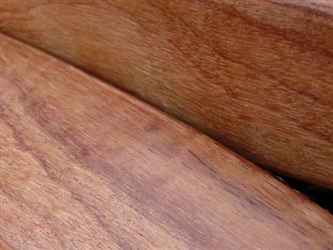 |
Canary Wood
Canary Wood is a strong exotic wood from Panama to Southern Brazil that because of its stiffness delivers a medium high tone.
This intriguing wood is dull brown when freshly cut, then rapidly changes to a bright, vibrant purple. Exposure to air darkens the wood to a dark-purplish brown, eventually turning it dark brown.
This rare wood exhibits a medium to high luster. Canary Wood is noted for its usually pale yellowish-orange color sometimes accented with rich red streaks which form a "rainbow hue."
Bone Rattling Facts
Canary Wood offers excellent acoustical properties for musical instruments and loudspeaker enclosures. It is a hard, heavy and strong material well suited for hand-held musical instruments because it is impervious to liquids and rated highly resistant to attacks from decay, fungi and insects.
Cool Facts
Being impervious to liquid, Canary Wood was used by coopers to make barrels. The U.S. Forest Service lists Canary Wood under the botanical name Centrolobium which is of the family Leguminosae - which means Canary Wood is a member of the legume or pea family. In fact, "it has pods with seeds," reports noted wood expert Gene "Wood Doctor" Wengert, Professor Emeritus at the University of Wisconsin-Madison, adding, "It looks somewhat like the maple seed and its wing."
Figures below are approximate (but pretty darn close)
Tonality
Can't Decide Which Bones to Choose?
Check out this handy guide: Bone FAQs
Scroll down for technical Canary Wood facts...
|
|
Canary Wood Facts
Scientific Name
Centrolobium microchaete (aka: Centrolobium ochroxylon, Centrolobium paraense, Euxylophora paraensis)
Other Names
According to Professor Wengert, "Canary wood is known by more than 40 common names...all the various species that are sold as Canary Wood...are so similar in appearance and properties that they can be safely lumped together."
Amarello
Amarello vinhatico
Amarelo-cetim
Amarillo guayaquil (Panama, Ecuador)
Ararauba, Ararauva (Brazil)
Arariba
Balaustre (Colombia, Venezuela)
Bois bresil
Boxwood
Brazilian boxwood
Brazilian satinwood
Cetim
Guayacan hobo
Limao rana
Limao-rana
Morosimo (Paraguay)
Muira-taua
Muirataua
Pao amarello
Pao setim
Para-amarello
Pau
Pau amarello
Pau setim
Pau-cetim
Pequia cetim
Pequia setim
Porcupine wood
Putumuju
Satean wood
Sateen wood
Satinwood
Vinhatico de espinho
Vinhatico de macaco
Grain
The grain has a medium texture and small pores. It is typically straight, but can be irregular or wiggly on some pieces.
Texture
The texture varies from fine to coarse. Canary Wood is easy to work with hand or power tools. It sands, glues and takes a finish well.
Heartwood Color
Yellowish Orange (banana caramel ripple)
The heartwood is usually a pale yellowish-orange, sometimes with rich red streaks forming a "rainbow hue" that can eventually darken and change to brown with age.
Sapwood Color
The rather sharply demarcated sapwood varies from white to yellow.
Aroma
The U.S. Forest Service reports that some species are without odor or taste, while other species exhibit a distinctive odor and sometimes a perceptive taste.
Environmental Profile
Vulnerable in parts of its natural habitat. The International Tropical Timber Organization (ITTO) reports that Canary Wood is a fairly important source of timber and is frequently exported.
Distribution
Grows almost exclusively in dry land areas of Brazil's Para State in the lower Amazon. The U.S. Forest Service reports that five or six species of rather infrequent occurrence grow from Panama to Ecuador and southern Brazil.
Tree Data
Typically 40 feet tall and around 16 inches in diameter. Mature trees can exceed a height of 100 feet with a diameter of 4 feet or more.
|
|
|